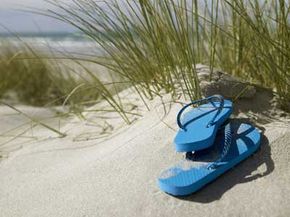Who calls the sand dune home?
You'd think a pile of sand could never support a thriving ecosystem. But sand dunes host countless numbers of organisms. From sweet-smelling flowers to small rodents, many living things have adapted to a life in the sand. Dune vegetation pays back the favor by protecting the dunes from damage.
Obviously, desert and dune plants must be drought-tolerant. Some plants store rainwater in their leaves and stems, while other plants have long root systems that burrow down to the water table. The long roots tend to stabilize and anchor the dunes, preventing them from eroding during a storm. Some of the plants and flowers that grow in sand dunes include: pink sand verbena, white dune evening primrose and yellow sunflower. Shrubs are also well suited for dune life, and many animals rely on bushes like mesquite, creosote bush and desert buckwheat for shade and shelter.
Advertisement
Sand snakes and lizards also call sand dunes home. These reptiles burrow rapidly through the sand, an action known as sand swimming. Hundreds or even thousands of types of insects also make their habitats in sand dunes. Beetles, moths, wasps, flies, crickets and spiders all live in the sand. Many of these insects prey on each other as well as feed on dune vegetation. Certain rodents also can live in sand dunes and create complicated burrows within the dunes, emerging to feed on the seeds and leaves of dune plants.
Vegetation on coastal dunes is particularly important because it helps to anchor the dunes and protect them from damage and erosion. The most common vegetation you'll see on coastal dunes is dune grass. Dune grass grows in the sand, requires full sun and can withstand salt spray. The grass has long, flexible stems that help it to withstand forceful winds. Powerful sprawling root systems help anchor it in the sand and also protect the dune from erosion. Sea turtles are also important to coastal sand dunes. Many turtles nest in the sand, and their eggs provide valuable nutrients for dune vegetation.
Because these fragile ecosystems are all dependent on each other, it's important to protect sand dunes. Beaches and sand dunes need each other -- beaches need the dune's sand reservoirs in order to replenish after a storm, and dunes need the beach's sand to form in the first place. Coastal sand dunes suffer from erosion during storms and hurricanes and when humans interfere. Deforestation also contributes to sand dune erosion because loss of vegetation makes the dunes unstable. As sand dunes lose sand -- perhaps from waves reaching them during a particularly strong storm, or because humans disturb their structure -- they also lose their ability to absorb storm surges. Dunes can take decades to recover from this sort of destruction [source: CSI].
The reason you see "Stay Off the Dunes" signs at the beach or lake is because walking around on the dunes can damage the vegetation. And, as we've learned, the long root systems of dune vegetation help to keep the dunes anchored and stable.
For more information about sand dunes and other natural wonders, visit the links below.
Related HowStuffWorks Articles
- How Desert Survival Works
- How Quicksand Works
- The Sahara Desert
- How Mirages Work
- How the Grand Canyon Works
- What are oil sands?
- Is the Dead Sea really dead?
- Great Sand Dunes National Park
- How Barrier Islands Work
- How Landslides Work
- How Avalanches Work
- Why don't we live underground?
- How Cave Dwellers Work
- How Snowboarding Works
More Great Links
- Singing Sand Dunes
- Great Sand Dunes National Park
- Geology of Sand Dunes
- Earth's Creeping Deserts
- Sand Dunes on Mars
Sources
- Armstrong, Wayne P. "The Life & Love of Sand Dunes." Desert USA. 2008. (Oct. 15, 2008) http://www.desertusa.com/magjan98/dunes/jan_dune1.html
- Bell, Trudy E. and Phillips, Dr. Tony. "City-swallowing Sand Dunes." Science@NASA. Dec. 6, 2002. (Oct. 15, 2008) http://science.nasa.gov/headlines/y2002/06dec_dunes.htm
- Chang, Kenneth. "Secrets of the Singing Sand Dunes." NY Times. Jul. 25, 2006. (Oct. 15, 2008) http://www.nytimes.com/2006/07/25/science/25find.html
- "Coastal Sand Dunes." Capital Regional District. 2007. (Oct. 15, 2008) http://www.crd.bc.ca/watersheds/ecosystems/coastalsanddunes.htm
- "Coasts: Sand and Dunes." U.S. Geological Survey. Jan. 19, 2004. (Oct. 15, 2008) http://geology.wr.usgs.gov/parks/coast/dunes/index.html
- Creager, Ellen. "Dune what comes naturally at Sleeping Bear." Detroit Free Press. Sept. 21, 2008. (Oct. 15, 2008)http://www.freep.com/apps/pbcs.dll/article?AID=/20080921/FEATURES07/809210320/1032
- "Desert Features." U.S. Geological Survey. Oct. 29, 1997. (Oct. 15, 2008) http://pubs.usgs.gov/gip/deserts/features/
- "Great Sand Dunes National Monument." USParkInfo.com. 2008. (Oct. 15, 2008) http://www.usparkinfo.com/greatdune.html
- "Mars image shows wind-sculpted sand dunes." Telegraph.co.uk. Apr. 11, 2008. (Oct. 15, 2008) http://www.telegraph.co.uk/earth/main.jhtml?xml=/earth/2008/04/11/scimars111.xml
- Martin, Glen. "City's beautiful but hidden sand dunes." San Francisco Chronicle. Jul. 20, 2006. (Oct. 15, 2008) http://www.sfgate.com/cgi-bin/article.cgi?f=/c/a/2006/07/20/SANDDUNES.TMP
- O'Connor, Anahad. "When Sand Dunes Collide, Sometimes They Mate and Multiply." NY Times. Dec. 23, 2003. (Oct. 15, 2008) http://query.nytimes.com/gst/fullpage.html?res=9B06E2DB103FF930A15751C1A9659C8B63
- "Sand Dunes." Desert USA. 2008. (Oct. 15, 2008) http://www.desertusa.com/geofacts/sanddune.html
- Schevitz, Tanya. "11-year-old boy killed in sand dune collapse." SFGate. Oct. 13, 2008. (Oct. 15, 2008) http://www.sfgate.com/cgi-bin/article.cgi?f=/c/a/2008/10/12/BAR913G016.DTL
- Sink, Mindy. "Adventurer | Sandboarding." NY Times. Apr. 9, 2004. (Oct. 15, 2008)http://query.nytimes.com/gst/fullpage.html?res=9E07E2D91538F93AA35757C0A9629C8B63
- "Types of Dunes." U.S. Geological Survey. Oct. 29, 1997. (Oct. 15, 2008) http://pubs.usgs.gov/gip/deserts/dunes/
- "What is sand made of?" SEED Science Center. 2008. (Oct. 15, 2008)http://www.seed.slb.com/qa2/FAQView.cfm?ID=896
- "When Sand Dunes Have Been Destroyed." UNESCO. March 2007. (Oct. 15, 2008)http://www.unesco.org/csi/pub/source/ero9.htm
